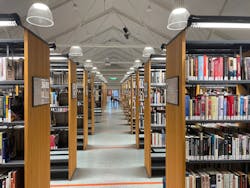With “energy savings” topping the list of selling points for LED lighting like never before, and with a European ban of fluorescent tubes set to take hold, Fagerhult Group is ratcheting up efforts to provide low-cost retrofits of existing luminaires that currently house conventional light sources.
The retrofit push is part of a broader initiative by the Swedish lighting company to grow business in the renovation sector, which also includes bigger projects that involve knocking down walls and ripping up ceilings.
The renovation market — both simple retrofits as well as structural redesign — is distinct from new builds, and is driving the company’s business strategy as a result of soaring energy prices and global warming imperatives facing end users.
“
The market opportunity is strong given that only about 30% of European commercial users have so far converted to LED, she noted.
Fagerhult runs more than 12 lighting companies. Some of those currently garner as much as 90% of their business from renovations. For others, the renovation/new build quotient is around 50/50.
But the renovation portion will grow.
“It's already a high number, and we can see the focus is going to be even more renovation for the coming years,” Sonesson told one analyst who had inquired about the mix.
The EU's pending ban on fluorescent tubes, set to take hold in phases by September 2023, will further propel the renovation upswing.
To help lower renovation prices, Fagerhult has devised retrofit products and service offerings that will make it easier for existing customers to snap out conventional light sources and replace them with LED versions.
“Retrofit for us means changing only the light source and keeping the existing light fitting’s housing,” Sonesson said. “One of the advantages of retrofit is we don't have to make any changes to the ceiling.”
Fagerhult also endeavors to include its Organic Response brand of sensors in the retrofits, which would intelligently adjust light levels as needed and bring total energy savings up to 90% compared to conventional light sources, she noted.
“It's possible to keep the original design and significantly reduce the energy consumption,” Sonesson said.
For example, Fagerhult is offering an LED retrofit version of its ateljé Lyktan “Supertube,” marketing it as “Second Life.”
A Fagerhult spokesperson told LEDs Magazine that the lighting company hopes to tailor retrofit solutions by leveraging the nearness of its manufacturing plants in certain instances.
“Retrofit by nature is very customized and bespoke projects, so it becomes much more of a 'service offering' than traditional product sales,” he said.
With the demand for lower-priced retrofits rising, “We have formalized our business processes to better meet the demand,” the spokesperson noted. “We see retrofit more as a regular offering and have processes for this at our different brands.”
The energy savings message has never faded away from the LED lighting industry’s marketing push and raison d’être. But it is receiving revived attention with the current world energy situation, something that other vendors such as Signify have illustrated on more than one occasion, and that Glamox has also noted.
While energy savings present a strong selling point, customers must consider the upfront cost of LED lighting in their purchasing decisions. Such expenses have caused users in the horticultural sector to pause on buying LEDs, ironically because growers’ energy costs have soared to the point of straining their capital expenditure budgets, as both ams Osram and Signify reported in their third quarters.
In the commercial office sector, lower-priced retrofit options could help avoid a similar scenario.
Meanwhile, Fagerhult is pursuing IoT business opportunities. And it continues to pay heed to lighting design, having recently added the Crystal luminaire for architectural LED ceiling lighting to its iGuzzini line, and the NanoOptix wall washer model to its LTS brand. Both models deploy new optics. They come following several other new models that feature advances not only in light quality but also in sound absorption and in reusability.
Fagerhult divides its business into four divisions: the design-oriented Collection division, with iGuzzini (including Montreal-based Sistemalux), ateljé Lyktan, LED Linear, and WE-EF brands; Premium, which focuses on European customers and bespoke solutions via Fagerhult and LTS brands; Professional, which focuses on indoor lighting in local markets and includes Australia's Eagle, the U.K.’s Whitecroft, and Turkey's Arlight; and Infrastructure, aimed at robust environments and including the brands Designplan, i-Valo, and Veko.
MARK HALPER is a contributing editor for LEDs Magazine, and an energy, technology, and business journalist ([email protected]).
For up-to-the-minute LED and SSL updates, follow us on Twitter. You’ll find curated content and commentary, as well as information on industry events, webcasts, and surveys on our LinkedIn page and our Facebook page.

Mark Halper | Contributing Editor, LEDs Magazine, and Business/Energy/Technology Journalist
Mark Halper is a freelance business, technology, and science journalist who covers everything from media moguls to subatomic particles. Halper has written from locations around the world for TIME Magazine, Fortune, Forbes, the New York Times, the Financial Times, the Guardian, CBS, Wired, and many others. A US citizen living in Britain, he cut his journalism teeth cutting and pasting copy for an English-language daily newspaper in Mexico City. Halper has a BA in history from Cornell University.





